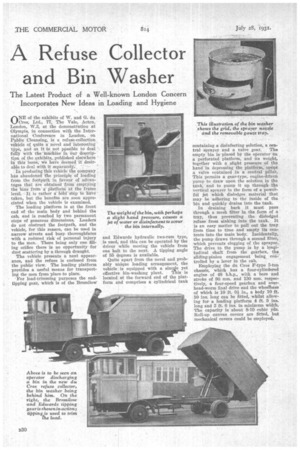A Refuse Collector
Page 48

If you've noticed an error in this article please click here to report it so we can fix it.
and Bin Washer
The Latest Product of a Well-known London Concern Incorporates New Ideas in Loading and Hygiene
ONE of the exhibits of W. and G. du Cros, Ltd, 77, The Vale, Acton, London, W.3, at the demonstration at Olympia, in connection with the International Conference in London, on Public Cleansing, is a refuse-collection vehicle of quite a novel and interesting type, and as it is not ppssible to deal fifty with the-machine in bur description of the exhibits, published elseithere ' Iii this issue, We have deemed it desirable to deal with it separately.. .
In producing this vehicle the company , has abandoned' the principle of loading from the footpath in favour of advantages that are obtained from emptying the bins frOM a: platform at the frame level. It is rather a' bald step to have taken, but the benefits are soon appreciated when the vehicle is examined.
The loading platform is at the front end of the main body and behind the cab, and is reached by two permanent steps of generous dimensions. Loaders do not obstruct the footpath, and the vehicle, for this reason, can be used in narrow streets and busythoroughfares with a reduced risk of personal injury to the men. There being only one filling orifice there is no opportunity for dust scattering by a through draught.
The vehicle presents a neat appearance, and the refuse is enclosed from the public view. The loading platform provides a useful means for transporting the men from 'place to place.
For load-trimming purposes the endtipping gear, which is of the Brorailow
and Edwards hydraulic two-ram type, is used, and this can be operated by the driver while moving the vehicle from one halt to the next A tipping angle of 55 degrees is available.
Quite apart from the novel and probably unique loading arrangement, the vehicle is equipped with a simrje yet effective bin-washing plant. This is located at the forward end of the platform and comprises a cylindrical tank
containing a disinfecting solution, a cen
tral Sprayer and a valve gear. The empty bin is placed by the operator On a perforated platform, and its weight, together with a slight pressure of the hand in depressing the platform, opens a valve contained in a central pillar. This permits a gear-type, engine-driven pump to draw upon the solution in the tank, and to pump it up through the vertical sprayer in the form of a powerful jet which dislodges material that may he adhering to the inside of the bin and quickly drains into the tank.
In draining back it must pass through a mesh filter in the form of a tray, thus preventing the dislodged refuse from sinking into the tank. It is an easy matter to pull out the tray from time to time and empty its contents into the main body. Incidentally, the pump. draws through a second filter, which prevents clogging of the sprayer. The drive to the pump is by a longitudinal shaft from the gearbox, the sliding-pinion engagement being controlled by a lever in the cab.
Employing the du Cros F-type 3-ton chassis, which has a four-cylindered engine of 48 b.h.p., with a bore and stroke of 90 mm. and 130 ram. respectively, a four-speed gearbox and overhead-worm final drive and the wheelbase of which is 10 ft. 0.i in., a body 10 ft. 10 ins, long can be fitted, whilst allowing for a lnading platform 4 ft. 5 ins. long and 3 ft. 6 inn in minimum width. The capacity is about 8-10 cubic yds. Roll-up canvas covers are fitted, but mechanical covers could be employed.




































































































